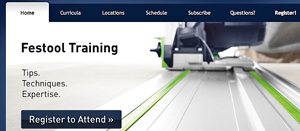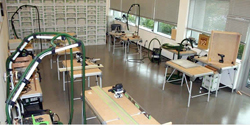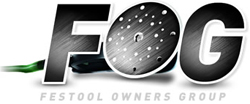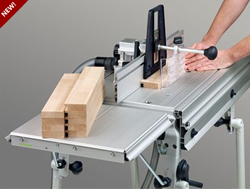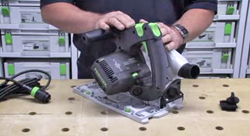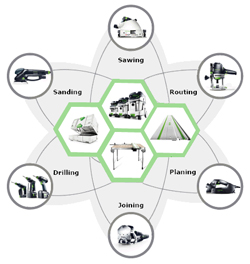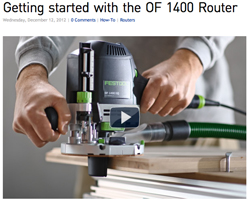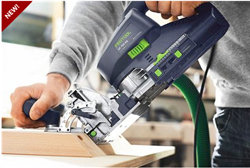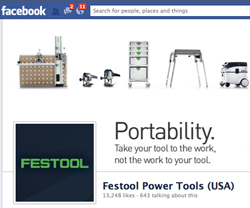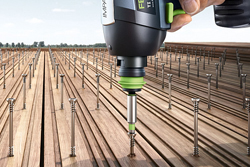
Most of us probably don’t consider a tool purchase to be the beginning of a relationship with the tool’s manufacturer. We buy it, and then we use it more or less unsupported unless there are warranty or repair issues. That’s the long and short of it; the “relationship” begins and ends at the point of purchase. But Festool sees things differently in terms of its approach to end-customer satisfaction: buying the tool is just the beginning. Supporting customers from there is an opportunity to engage on many levels in order to help users work smarter, faster and more easily. To that end, the company is reaching out in a variety of ways.
“It’s always been in our DNA to really engage with our customers, especially here in the U.S.,” says Michael Williams, vice president of product marketing. “We’re a relatively small company, so we have to be very much in touch with those who make a commitment to using our tools. Most of our customers are professionals who make a living with them, and that’s where we set our bar. We not only want to help them learn how to use their specific tools, but even more importantly how to arrive at solutions for the work they need to do.”
One way to focus on the “solutions” aspect was begun just two years ago, when the company launched a series of end user training classes. Williams says the idea grew out of the company’s dealer training program, which it has maintained for years. At one point dealers wanted more in-depth training than merely the “nuts and bolts” of how to use Festool products, so Festool took a novel approach. The company started teaching its dealer network how to build things with the product line so the tools became the means to a solution, be it a cabinet, a door, a drawer or a trim carpentry project.
“Then customers found out about it, and they wanted that kind of experience, too.”
Now Festool offers a half dozen different end user classes, ranging from finish carpentry to cabinet building and advanced routing techniques. Class sizes are kept small, with just six people per class and a trainer. The training takes place either at Festool’s headquarters in Lebanon, Indiana, or a second site in Las Vegas, Nevada, over a two-day period. Meals and materials are provided for a tuition fee of $250. Students must arrange for their own transportation, but Williams says they’re nabbing the opportunity to attend a class about as fast as new classes can be scheduled. Currently, more than 1,000 people are on a waiting list for future classes, “and when we post a new course schedule on festooltraining.com, the classes often fill in minutes. The response has been just huge for this kind of small group training!”
Customers are also eager for the opportunity to mingle with Festool staff and get their hands on the latest tools. Last year, the company held its first “Festool Connect” event in Providence, Rhode Island, concurrent with another trade publication’s national event. “We had nearly 200 of our customers show up for the first ‘Connect.’ It was a great opportunity to share our new products and get their feedback,” Williams says. Festool is planning another daylong “Connect” event in either February or March of next year, and early registration will be available online for it soon on Festool’s web site.
But if you can’t travel to Rhode Island, Indiana or Nevada for intensive training or hands-on time, there may be a live demo happening at Festool dealership near you. Dealer demos are ongoing, and Williams says they’re usually hosted by Festool-trained professional contractors and other tradespeople and are open to the public. Click here to see a calendar of demo locations and dates.
Scheduled Festool events of these kinds provide helpful reactions from tool users, but so does unsolicited, candid online feedback. One very active Internet forum, called Festool Owner’s Group (FOG), was begun in 2005 by a Festool customer. Four years later, the company took it under the Festool umbrella. But Williams says that Festool has left FOG largely alone so that end users can feel free to talk about whatever they want to with other end users — be it about tools, projects or otherwise. And, he adds, that’s why the forum works so well. FOG has garnered a global audience, sometimes receiving hundreds of posts each day from Festool users both in the United States and abroad.
“FOG is extremely organic … we really only censor the forum for safety issues or obscene content. We do not take down negative comments about our tools, because we want absolutely honest interaction to be happening there. We learn a lot from it.”
Occasionally Festool professionals and even company CEO Christian Oltzscher will post comments, but only as fellow participants in discussions in order to answer questions or offer clarifications.
Other forms of free online support include Festool’s Facebook page as well as its 13-page “SysNotes” electronic newsletter, which the company sends out about 12 times per year. It also has an expanding presence on YouTube. “Festool Power Tools TV offers all sorts of end user produced videos about our tools as well as videos we create internally. They cover setup and usage issues, and some of them offer very detailed information about the finer points of our product line,” Williams says.
Whether through dealer demos, a newsletter, intensive class sessions or a video that’s just a few clicks away, Festool is committed to offering a broad base of end user support, and most of it is free of charge. While some may feel that Festool offers prohibitively expensive tools, even with a far-reaching network of support options, Williams counters the “Festool is too expensive” argument this way: “We absolutely believe that our tools are worth every penny and will pay for themselves, and that’s what we want to show you in every way we can. We’re happy to walk away from a sale if it’s not truly the right tool for you … and we’ve always offered a 30-day no-questions-asked guarantee.” He laughs, “But people rarely take us up on that return option. Once they use our tools and experience the value we build into them, they’re sold.”
